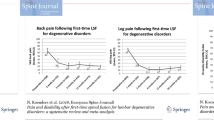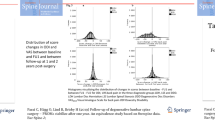Abstract
Background
Comparative effectiveness research in spine surgery is still a rarity. In this study, pain alleviation and quality of life (QoL) improvement after lumbar total disc arthroplasty (TDA) and anterior lumbar interbody fusion (ALIF) were anonymously compared by surgeon and implant.
Methods
A total of 534 monosegmental TDAs from the SWISSspine registry were analyzed. Mean age was 42 years (19–65 years), 59 % were females. Fifty cases with ALIF were documented in the international Spine Tango registry and used as concurrent comparator group for the pain analysis. Mean age was 46 years (21–69 years), 78 % were females. The average follow-up time in both samples was 1 year. Comparison of back/leg pain alleviation and QoL improvement was performed. Unadjusted and adjusted probabilities for achievement of minimum clinically relevant improvements of 18 VAS points or 0.25 EQ-5D points were calculated for each surgeon.
Results
Mean preoperative back pain decreased from 69 to 30 points at 1 year (ØΔ 39pts) after TDA, and from 66 to 27 points after ALIF (ØΔ 39pts). Mean preoperative QoL improved from 0.34 to 0.74 points at 1 year (ØΔ 0.40pts). There were surgeons with better patient selection, indicated by lower adjusted probabilities reflecting worsening of outcomes if they had treated an average patient sample. ALIF had similar pain alleviation than TDA.
Conclusions
Pain alleviation after TDA and ALIF was similar. Differences in surgeon’s patient selection based on pain and QoL were revealed. Some surgeons seem to miss the full therapeutic potential of TDA by selecting patients with lower symptom severity.






Similar content being viewed by others
Abbreviations
- ALIF:
-
Anterior lumbar interbody fusion
- COMI:
-
Core outcome measures index
- EQ-5D:
-
EuroQoL-5D instrument
- MCRIQL:
-
Minimum clinically relevant improvement of quality of life = 0.25 EQ-5D points [2]
- MCRPI:
-
Minimum clinically relevant pain improvement = 18 VAS points [10]
- NASS:
-
North American Spine Society outcome assessment instrument
- QoL:
-
Quality of life
- TDA:
-
Total disc arthroplasty
- VAS:
-
Visual analogue scale
References
Schluessmann E, Aghayev E, Staub L, Moulin P, Zweig T, Roder C (2010) SWISSspine: the case of a governmentally required HTA-registry for total disc arthroplasty: results of cervical disc prostheses. Spine (Phila Pa 1976) 35:E1397–E1405. doi:10.1097/BRS.0b013e3181e0e871
Schluessmann E, Diel P, Aghayev E, Zweig T, Moulin P, Roder C (2009) SWISSspine: a nationwide registry for health technology assessment of lumbar disc prostheses. Eur Spine J 18:851–861. doi:10.1007/s00586-009-0934-8
Aghayev E, Roder C, Zweig T, Etter C, Schwarzenbach O (2010) Benchmarking in the SWISSspine registry: results of 52 Dynardi lumbar total disc replacements compared with the data pool of 431 other lumbar disc prostheses. Eur Spine J 19:2190–2199. doi:10.1007/s00586-010-1550-3
Melloh M, Staub L, Aghayev E, Zweig T, Barz T, Theis JC, Chavanne A, Grob D, Aebi M, Roeder C (2008) The international spine registry SPINE TANGO: status quo and first results. Eur Spine J 17:1201–1209. doi:10.1007/s00586-008-0665-2
Roder C, Staub L, Dietrich D, Zweig T, Melloh M, Aebi M (2009) Benchmarking with Spine Tango: potentials and pitfalls. Eur Spine J 18(Suppl 3):305–311. doi:10.1007/s00586-009-0943-7
Zweig T, Mannion AF, Grob D, Melloh M, Munting E, Tuschel A, Aebi M, Roder C (2009) How to Tango: a manual for implementing Spine Tango. Eur Spine J 18(Suppl 3):312–320. doi:10.1007/s00586-009-1074-x
Kessler JT, Melloh M, Zweig T, Aghayev E, Roder C (2011) Development of a documentation instrument for the conservative treatment of spinal disorders in the International Spine Registry, Spine Tango. Eur Spine J 20:369–379. doi:10.1007/s00586-010-1474-y
Mannion AF, Porchet F, Kleinstuck FS, Lattig F, Jeszenszky D, Bartanusz V, Dvorak J, Grob D (2009) The quality of spine surgery from the patient’s perspective. Part 1: the Core Outcome Measures Index in clinical practice. Eur Spine J 18(Suppl 3):367–373. doi:10.1007/s00586-009-0942-8
Errico TJ (2005) Lumbar disc arthroplasty. Clin Orthop Relat Res:106–117. pii:00003086-200506000-00016
Hagg O, Fritzell P, Nordwall A (2003) The clinical importance of changes in outcome scores after treatment for chronic low back pain. Eur Spine J 12:12–20. doi:10.1007/s00586-002-0464-0
Roder C, Chavanne A, Mannion AF, Grob D, Aebi M (2005) SSE Spine Tango—content, workflow, set-up. Eur Spine J 14:920–924. doi:10.1007/s00586-005-1023-2. www.eurospine.org(SpineTango)
Acknowledgments
We thank Daniel Dietrich, PhD, for statistical consulting in all analyses presented in the current article. We are indebted to the SWISSspine and Spine Tango registry groups who made this research possible by populating the database with their valuable and much appreciated entries. The analysed data were recorded by: Bärlocher C (n = 76), Sgier F (n = 65), Etter C (n = 41), Hausmann O (n = 40), Schwarzenbach O (n = 38), Huber J (n = 36), Aebi M (n = 31), Heini P (n = 23), Berlemann U (n = 23), Markwalder T (n = 19), Otten P (n = 17), Schaeren S (n = 16), Maestretti GL (n = 12), Schizas C (n = 12), Waelchli B (n = 12), Porchet F (n = 10), Baur M (n = 9), Kast E (n = 9), Seidel U (n = 9), Lutz T (n = 7), Grob D (n = 6), Jeanneret B (n = 5), Kroeber M (n = 5), Min K (n = 5), Hasdemir M (n = 4), Lattig F (n = 4), Morard M (n = 4), Renella R (n = 4), Richter H (n = 4), Van Domelen K (n = 4), Wernli FO (n = 4), Binggeli R (n = 3), Stoll TM (n = 3), Marchesi D (n = 3), Tessitore E (n = 3), Vernet O (n = 3), Faundez A (n = 2), Favre J (n = 2), Ramadan A (n = 2), Selz T (n = 2), Boos N (n = 1), Cathrein P (n = 1), Forster T (n = 1), Heilbronner R (n = 1), Kleinstueck F (n = 1), Martinez R (n = 1), Rischke B (n = 1).
Conflict of interest
None of the authors has any potential conflict of interest.
Author information
Authors and Affiliations
Consortia
Corresponding author
Rights and permissions
About this article
Cite this article
Aghayev, E., Henning, J., Munting, E. et al. Comparative effectiveness research across two spine registries. Eur Spine J 21, 1640–1647 (2012). https://doi.org/10.1007/s00586-012-2256-5
Received:
Revised:
Accepted:
Published:
Issue Date:
DOI: https://doi.org/10.1007/s00586-012-2256-5




